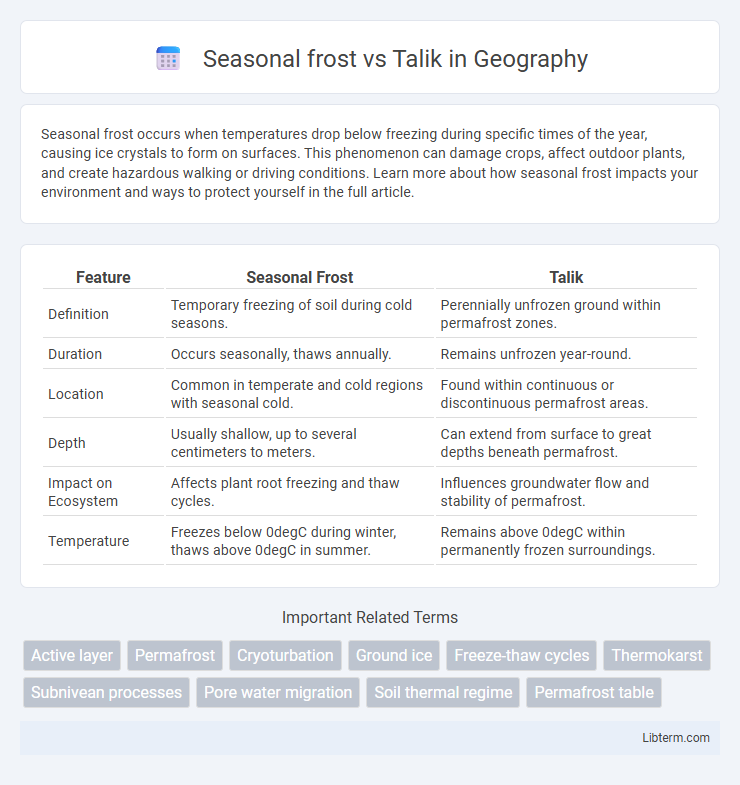Seasonal frost occurs when temperatures drop below freezing during specific times of the year, causing ice crystals to form on surfaces. This phenomenon can damage crops, affect outdoor plants, and create hazardous walking or driving conditions. Learn more about how seasonal frost impacts your environment and ways to protect yourself in the full article.
Table of Comparison
| Feature | Seasonal Frost | Talik |
|---|---|---|
| Definition | Temporary freezing of soil during cold seasons. | Perennially unfrozen ground within permafrost zones. |
| Duration | Occurs seasonally, thaws annually. | Remains unfrozen year-round. |
| Location | Common in temperate and cold regions with seasonal cold. | Found within continuous or discontinuous permafrost areas. |
| Depth | Usually shallow, up to several centimeters to meters. | Can extend from surface to great depths beneath permafrost. |
| Impact on Ecosystem | Affects plant root freezing and thaw cycles. | Influences groundwater flow and stability of permafrost. |
| Temperature | Freezes below 0degC during winter, thaws above 0degC in summer. | Remains above 0degC within permanently frozen surroundings. |
Introduction to Seasonal Frost and Talik
Seasonal frost refers to the temporary freezing of soil or ground surface that occurs during colder months and thaws with rising temperatures, commonly found in temperate climates. Talik is a layer of unfrozen ground that lies between the frozen surface and deeper permafrost or frozen ground, often acting as a thermal buffer in permafrost regions. Understanding the dynamics between seasonal frost and talik is crucial for studying soil temperature variations, permafrost stability, and their impacts on ecosystems and infrastructure.
Defining Seasonal Frost: Key Characteristics
Seasonal frost refers to the upper layer of soil that freezes during the winter months and thaws in the spring, typically affecting regions with cold but fluctuating temperatures. It is characterized by its temporary freeze-thaw cycle, with depths varying from a few centimeters to several meters depending on local climate and soil conditions. Unlike talik, which denotes unfrozen ground within or beneath permafrost, seasonal frost does not persist year-round and impacts soil moisture and thermal regimes only seasonally.
Understanding Talik: Features and Formation
Talik refers to a layer of unfrozen ground that exists within permafrost areas, remaining unfrozen due to geothermal heat or insulating snow cover despite the surrounding frozen soil. It typically forms beneath lakes, rivers, or areas with thin seasonal frost, acting as a thermal buffer that influences permafrost stability and hydrology. Understanding talik formation is crucial for assessing permafrost dynamics, infrastructure risks, and carbon release in cold regions affected by climate change.
Geographic Distribution of Seasonal Frost vs Talik
Seasonal frost predominantly occurs in temperate and subarctic regions where surface temperatures drop below freezing during winter but thaw completely in warmer months, such as parts of North America, Europe, and Asia. Talik forms in permafrost zones, mainly in Arctic and sub-Arctic regions like Siberia, northern Canada, and Alaska, where unfrozen ground persists beneath the seasonally thawed active layer or under lakes and rivers. The geographic distribution of seasonal frost is limited to regions with distinct seasonal temperature fluctuations, whereas talik presence indicates underlying permafrost continuity interrupted by localized thawed zones.
Formation Processes: How Seasonal Frost and Talik Develop
Seasonal frost forms when surface temperatures drop below freezing during colder months, causing water in the soil to freeze and create a temporary frozen layer. Talik develops in permafrost regions where unfrozen ground exists beneath the active layer due to geothermal heat, insulating sediments, or the presence of water that lowers freezing points. The contrast in their formation processes lies in seasonal temperature fluctuations for frost versus persistent thermal anomalies causing talik underneath permafrost.
Impacts on Soil and Hydrology
Seasonal frost affects soil structure by causing expansion and contraction, leading to surface heaving and affecting water infiltration rates. Talik, an unfrozen zone beneath permafrost, alters soil thermal regimes and enables subsurface groundwater flow, impacting local hydrology and nutrient transport. The interaction between seasonal frost and talik influences soil moisture dynamics and groundwater recharge patterns in cold regions.
Ecological Effects of Seasonal Frost and Talik
Seasonal frost creates periodic freezing of the soil surface, affecting nutrient cycling and microbial activity during thaw periods, which influences plant growth and carbon sequestration. Talik, an unfrozen layer within permafrost, disrupts thermal insulation and hydrological flow, leading to altered groundwater dynamics and potential greenhouse gas emissions from thawed organic matter. These contrasting soil conditions directly impact ecosystem productivity and biodiversity in cold-region environments.
Human Activities Influenced by Each Layer
Seasonal frost limits construction timelines and agricultural practices due to its temporary soil freezing, impacting planting seasons and foundation stability. Talik, an unfrozen ground layer beneath permafrost, affects long-term infrastructure durability by causing uneven ground subsidence and complicating sewage and pipeline installations. Human activities like road building and energy extraction must adapt engineering techniques to mitigate risks associated with ground thawing and refreezing in these layers.
Climate Change Implications for Seasonal Frost and Talik
Seasonal frost, a temporary soil freezing layer, is increasingly vulnerable to warming temperatures, leading to reduced frost depth and shorter frost duration. Talik, unfrozen ground persisting within permafrost areas, expands as climate change intensifies, disrupting soil stability and hydrological systems. These shifts alter carbon release dynamics, amplifying greenhouse gas emissions and accelerating global warming feedback loops.
Comparative Summary: Key Differences and Similarities
Seasonal frost refers to the layer of soil that freezes and thaws annually, whereas talik denotes unfrozen ground within permafrost areas or beneath seasonal frost layers. Both seasonal frost and talik influence soil temperature dynamics and groundwater movement, but seasonal frost undergoes regular freezing cycles while talik remains persistently unfrozen. Understanding the distribution and interaction of these two phenomena is crucial for assessing ecological impacts and designing infrastructure in cold regions.
Seasonal frost Infographic

 libterm.com
libterm.com